The National Institute of Standards and Technology (NIST) is facing the looming prospect of significant layoffs, a consequence of sweeping management decisions from the current administration under President Donald Trump. This agency, critical for setting benchmarks that ensure the safety and reliability of a wide range of products and technologies, is now under pressure to conform to a new ethos of government efficiency. As rumors of layoffs circulate, employees are left grappling with uncertainty; a workplace traditionally regarded as a bastion of expertise and innovation is now bracing for the potential upheaval that comes with drastic cuts.
Reports suggest that approximately 500 employees, primarily recent hires still within their probation period, may be among the first casualties of this budgetary tightening. The rationale behind such austerity measures seems tied to an overarching directive from the administration that emphasizes a more streamlined government—coupled with the involvement of Elon Musk and his affiliated interests, which have directly shaped the federal landscape in unforeseen ways. With the specter of job loss looming, the psychological impact on employees is profound; they stand on shaky ground, torn between hope for institutional stability and fear of impending job cuts.
Unexpected Visitors and Intrapersonal Dynamics
The atmosphere at NIST has been further complicated by unusual activity within its premises. Reports of personnel associated with the Department of Government Efficiency (DOGE)—an entity that is unfamiliar to many within the agency—raising eyebrows and prompting concerns about the agency’s future. The involvement of DOGE in seeking access to NIST’s IT systems has fueled speculation about its intentions and the direction the agency may be forced to take. Employees reported seeing unexpected faces in Building 225, which serves as the nerve center for the NIST Information Technology Laboratory.
This intrusion was met with mixed emotions by current employees. While some were wary and skeptical, others welcomed the idea of new initiatives that could potentially enhance NIST’s resources. However, the ambiguity regarding DOGE’s motives bred distrust. Following these sightings, NIST leadership reassured employees that the DOGE personnel were not present on campus, yet the preparations made for their potential utility did little to quell the anxiety that had already set in.
Among the divisions primarily vulnerable to these changes is the U.S. AI Safety Institute (AISI), which has made significant strides in AI research and safety since its establishment under a previous administration. With the abrupt withdrawal of support for AI initiatives by the Trump administration, AISI faces an existential threat. The recent departure of key figures such as Elizabeth Kelly, the inaugural director, has left a gaping hole in its structure. The organization has been lauded for its collaborative efforts with leading AI firms, making its unraveling particularly disheartening for those invested in responsible AI development.
The shuffling of talent within NIST highlights broader discrepancies in agency priorities. The sudden resignation of its leading experts and directors signals a disconnect between the agency’s foundational goals and the newly defined framework expected by the current management. High-profile exits echo a resounding uncertainty; when the voices of those committed to AI safety begin to dwindle, so too does the potential for impactful decision-making within the agency.
Vice President JD Vance’s recent remarks underscored a stark shift in the administration’s approach to technology, specifically regarding AI safety. By emphasizing that safety is not a priority, the administration effectively communicates a perception that undermines years of effort toward responsible AI engagement. This strategic withdrawal from established safety frameworks not only threatens the future of AISI but also endangers a landscape where rapid technological advancements run unchecked.
The reverberations from these administrative changes extend beyond NIST and into the larger ecosystem of technological governance. With a significant number of experts exiting, innovations in AI safety may take a back seat, leading to potential risks with far-reaching implications. As institutions like NIST struggle to realign with the administration’s new directives, they face the dual challenges of preserving their core mission while navigating the fraught political terrain that governs federal operations.
As NIST faces an uncertain future marked by potential layoffs and shifts in focus, the implications are felt across its vast network of researchers, technologists, and policymakers. The unprecedented management changes initiated by the Trump administration raise fundamental questions about the prioritization of safety, governance, and innovation in the realm of technology. As the agency braces for what may be a tumultuous period, its trajectory and the well-being of its workforce hang in a precarious balance. The situation serves as a cautionary tale about the vulnerabilities inherent in politicizing essential scientific and regulatory agencies. In these unprecedented times, the resilience of NIST will certainly be put to the test.

